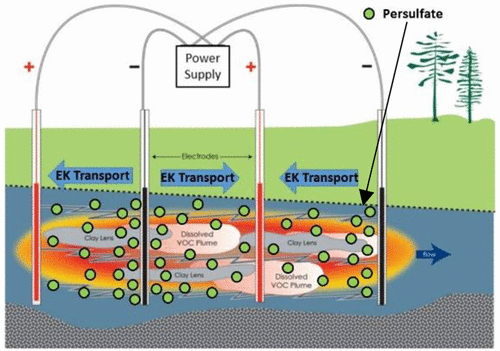当前位置:
X-MOL 学术
›
Environ. Sci. Technol.
›
论文详情
Our official English website, www.x-mol.net, welcomes your feedback! (Note: you will need to create a separate account there.)
Low Permeability Zone Remediation via Oxidant Delivered by Electrokinetics and Activated by Electrical Resistance Heating: Proof of Concept
Environmental Science & Technology ( IF 11.4 ) Pub Date : 2017-11-10 00:00:00 , DOI: 10.1021/acs.est.7b02231 Ahmed I. A. Chowdhury 1 , Jason I. Gerhard 1 , David Reynolds 2 , Denis M. O’Carroll 1, 3
Environmental Science & Technology ( IF 11.4 ) Pub Date : 2017-11-10 00:00:00 , DOI: 10.1021/acs.est.7b02231 Ahmed I. A. Chowdhury 1 , Jason I. Gerhard 1 , David Reynolds 2 , Denis M. O’Carroll 1, 3
Affiliation

|
This study proposes and proves (in concept) a novel approach of combining electrokinetic (EK)-assisted delivery of an oxidant, persulfate (PS), and low temperature electrical resistivity heating (ERH), to activate PS, to achieve remediation of contaminated, low permeability soil. This unique combination is able to overcome existing challenges in remediating low permeability materials, particularly associated with delivering remediants. A further benefit of the approach is the use of the same electrodes for both EK and ERH phases. Experiments were conducted in a laboratory-scale sand tank packed with silt and aqueous tetrachloroethene (PCE) and bracketed on each side by an electrode. EK first delivered unactivated PS throughout the silt. ERH then generated and sustained the target temperature to activate the PS. As a result, PCE concentrations decreased to below detection limit in the silt in a few weeks. Moreover, it was found that activating PS at ∼36 °C eliminated more PCE than activating it at >41 °C. It is expected this results from the reactive SO4•– radical being generated more slowly, which ensures more complete reaction with the contaminant. The novel application of EK-assisted PS delivery followed by low temperature ERH appears to be a viable strategy for low permeability contaminated soil remediation.
中文翻译:

通过电动势传递并通过电阻加热激活的氧化剂对渗透率低的区域进行修复:概念验证
这项研究提出并从概念上证明了一种新颖的方法,该方法结合了电动(EK)辅助的氧化剂,过硫酸盐(PS)和低温电阻加热(ERH)的输送,以激活PS,以实现对污染的补救,低渗透性土壤。这种独特的组合能够克服现有的低渗透性材料修复难题,尤其是与输送修复剂相关的难题。该方法的另一个好处是在EK和ERH相中使用相同的电极。实验是在装有淤泥和四氯乙烯(PCE)的实验室规模的沙池中进行的,并在每侧用电极将其固定。EK首先在整个淤泥中释放未激活的PS。然后,ERH产生并维持目标温度以激活PS。因此,PCE浓度在几周内下降到粉砂中的检测极限以下。此外,发现在约36°C下活化PS比在> 41°C下活化消除了更多的PCE。预计这是由于反应性SO4 •–自由基产生的速度较慢,从而确保与污染物的反应更加完全。EK辅助PS输送随后进行低温ERH的新应用似乎是低渗透性污染土壤修复的可行策略。
更新日期:2017-11-11
中文翻译:

通过电动势传递并通过电阻加热激活的氧化剂对渗透率低的区域进行修复:概念验证
这项研究提出并从概念上证明了一种新颖的方法,该方法结合了电动(EK)辅助的氧化剂,过硫酸盐(PS)和低温电阻加热(ERH)的输送,以激活PS,以实现对污染的补救,低渗透性土壤。这种独特的组合能够克服现有的低渗透性材料修复难题,尤其是与输送修复剂相关的难题。该方法的另一个好处是在EK和ERH相中使用相同的电极。实验是在装有淤泥和四氯乙烯(PCE)的实验室规模的沙池中进行的,并在每侧用电极将其固定。EK首先在整个淤泥中释放未激活的PS。然后,ERH产生并维持目标温度以激活PS。因此,PCE浓度在几周内下降到粉砂中的检测极限以下。此外,发现在约36°C下活化PS比在> 41°C下活化消除了更多的PCE。预计这是由于反应性SO4 •–自由基产生的速度较慢,从而确保与污染物的反应更加完全。EK辅助PS输送随后进行低温ERH的新应用似乎是低渗透性污染土壤修复的可行策略。


























 京公网安备 11010802027423号
京公网安备 11010802027423号